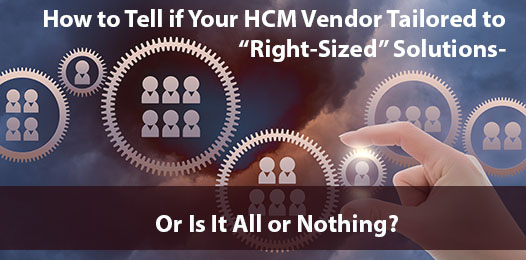Can Your HCM Vendor Deliver “Right-Sized” HCM Solutions?

How to Tell if Your HCM Vendor Can Deliver “Right-Sized” Solutions Vs. All or Nothing Approach?
The simple fact is, all businesses are different. While many businesses have similar requirements and responsibilities in terms of employees and compliance, no two companies are exactly alike. Because of this fact, different businesses each need their Human Capital Management (HCM) system to be flexible and configurable to a wide range of pay rules, processes, regulations without struggling to stay on top of compliance issues.
Most vendors pitch the all-in-one HCM solution for simplicity. However many times, these systems only offer very surface level capabilities that will lead to similar issues down the line. Here are the reasons that you want to an HCM solution that can be “right-sized” for your business.
The Problem with One-Size-Fits-All
The performance of your workforce has many dimensions. Montoring productivity, compliance, cost, and employee engagement, and more is complicated and can vary by specific industries. Take recruiting for example. Recruiting nurses is far different than recruiting store associates, which is far different from recruiting a machine tool cutting operator. Onboarding and scheduling your workforce also requires adhering to industry-specific rules as well.
With all this being true, it is important to ask tough questions during your HCM evaluation. One-size-fits-all vendors will typically talk to a compliance issue. Maybe they can show some a report. But if a certain configuration is important or automating a complex process is key to the project, would you take their word for it or would you want to see the capabilities in action? Forcing a proof of concept during the demo process can really differentiate the true all-in-one from the all-or nothings to ensure that the solution selected can be built to meet the complex, industry-specific requirements of your organization.
Is the HCM solution modular or does it require payroll?
There are a few different ways that payroll companies have evolved their HCM solutions. One way is by acquisition, buying other technologies and integrating them into the ecosystem. Another is through partnerships. This “payroll first methodology” is what most HR and payroll professionals are accustomed to.
However, a new breed of HCM solutions are breaking away from the payroll driven systems solves many of the inherent problems of tracking and reporting in a batch-data environment. Common reporting challenges like accrual tracking or payroll calculation errors can be solved prior to payroll runs, because pay calculation rules and time rules engines are configured and run in real-time.
How Extensive Custom Configurations Match Up to Standard Configurations?
Modern HCM technology should demonstrate a high level of configuration based on unique client needs. The systems operate based on profile settings and rules that allow for unlimited variation in configuration for differences in states, departments, or even individuals. These HCM solutions can do this without much effort because of the multi-tenant architecture. All clients are on the same version of the software eliminating upgrades, new platforms, and costs common with large payroll companies that have clients on a wide range of platforms.
As an example, let’s consider some common Time and Labor compliance calculations. Modern HCM solutions can be configured to accommodate most labor situations including complexities for union agreements, alternative work weeks, piece work, weighted average overtime, meal period penalties, and other complex pay calculations that may be unique to the states or municipalities operated in.
This is vastly different than one size fits all which offers surface deep data with little ability to accommodate workplace complexities, or the ability to see or modify the majority of the setup screens. When configurations are hard coded on back-office systems errors or issues are difficult to detect. Only after the payroll batch is run, do clients see errors, which causes additional risk and costs, compared with real-time rules configured to each clients’ unique business requirements.
How OnePoint HCM is the “Right-Sized” Solution?
Like many of these other HCM solutions, OnePoint HCM is a single database application. What makes OnePoint HCM stand apart though is that all modules can function as stand-alone services. For example, some OnePoint clients use only the Time and Labor Management, or HR, Scheduling, Benefits Enrollment, or any combination of modules.
In contrast most Payroll vendors, built on legacy payroll platforms, will require the conversion to their Payroll system, as it is the foundation of their system. They do not offer other stand-alone service modules making it all or nothing. This results in a Payroll-first methodology which is inherently problematic for many hourly, daily, and weekly tasks. This can present many challenges for HR and create limitations for most organizations.
Dependency on legacy payroll systems to make the HCM solution work is also why these companies bill on a per payroll basis. The payroll system controls billing. This often results in higher and unforeseen fees that are not in the proposals. This is a fact that most clients are not clear on at signing.
If your one-size-fits-all solutions can't optimize to your businesses’ practices and procedures, make sure you ask the next vendor to show how will they help you meet the needs of your entire workforce. This will help determine if their solution is fully compatible with all your needs. Check out what the “right-sized” solution looks like with help from OnePoint HCM. Meet industry-specific compliance and organizational requirements and get exactly what you need, when you need it, with OnePoint.
Subscribe to updates
Get the latest posts delivered to your inbox.